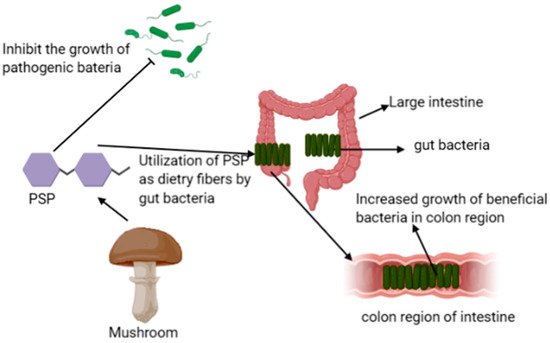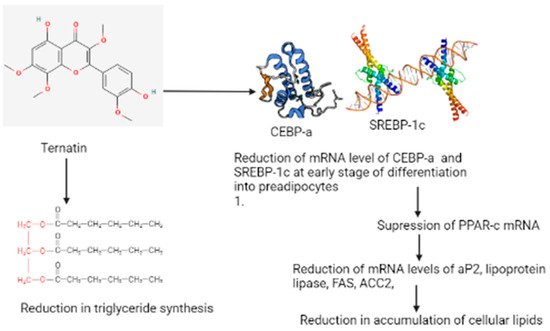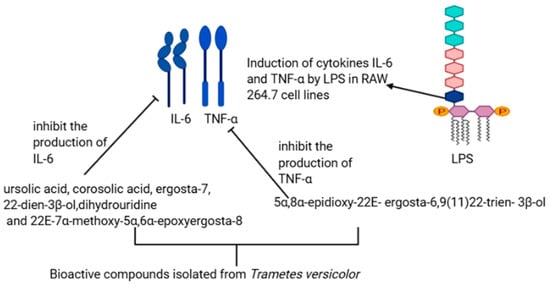Your browser does not fully support modern features. Please upgrade for a smoother experience.
Please note this is an old version of this entry, which may differ significantly from the current revision.
Subjects:
Medicine, Research & Experimental
W grzybie obecnych jest kilka związków bioaktywnych, które przypisują ludziom skuteczne wartości terapeutyczne i lecznicze. Tradycyjnie Trametes versicolor był spożywany ze względu na jego potencjalne właściwości zdrowotne, a naukowcy zbadali właściwości zdrowotne grzyba przy użyciu kilku metod in vitro, in vivo i chemicznych. Tutaj opisano bioaktywne składniki odpowiedzialne za znaczenie terapeutyczne.
- mushroom
- Trametes versicolor
- bioactivity
- health attributes
- anti-inflammation
1. Rola polisacharydów jako prebiotyków
Prebiotics are nondigestible ingredients of food that affect the host beneficially by promoting the growth of beneficial bacteria of the colon and improves the immunity of the host, and the intake of mushrooms as food enhances the growth of probiotic bacteria in the large intestine; therefore, it protects the human body from viral infections and inhibits the growth of disease-causing bacteria such as E. coli, Clostridium, and Salmonella (Figure 2) [34,35].

Figure 2. Possible mechanism of PSP of Trametes versicolor as prebiotics.
Edible mushrooms consist of pleuran, lentinan, schizophyllan, α and β-glucans, mannans, chitin, hemicellulose, galactans, and xylans polysaccharides that possess prebiotic effects. These polysaccharides increase the resistance to the intestinal mucosa and ulcer formation in the intestines of rats. In this regard, Yu et al. reported the effects of polysaccharopeptides (PSP) isolated from Trametes versicolor on the growth and activity of the probiotic bacteria Bifidobacteria and Lactobacilli [36]. The polysaccharides of Trametes versicolor possess different chemical constituents, including β-glucans as the principal components that are not easily digested by the intestinal enzymes. These polysaccharides, due to their non-starch and nondigestible natures, can be utilized as dietary fibers by gut probiotic bacteria in the large intestine and result in increased growth of these bacteria in the colon region, thereby providing health benefits, and are considered as potential prebiotics [35,37]. However, complete information regarding the ability of β-glycans of mushrooms to inhibit the composition of fecal microbes has not been investigated.
2. Antidiabetic and Antiobesity Properties
Type 2 diabetes results in chronic diseases, including diabetic nephropathy (disease related to the kidney), diabetic retinopathy (disease related to eyes), and diabetic neuropathy (nontraumatic lower-limb amputations). Due to continuous changes in the eating behavior and activity level of human beings, the incidence of type 2 diabetes is increasing continuously [38]. The disease results due to impaired secretion and resistance of insulin inside the body. The major risk effect for insulin resistance is obesity, and a strong relationship between these two factors has been reported in both animal and human studies [39]. Therefore, improvements in obesity result in the improvement of insulin sensitivity and the prevention of type 2 diabetes. Ternatin is a highly methylated cyclic heptapeptide.
Związek ten hamuje efekt akumulacji tłuszczu, co badano przy użyciu adipocytów 3T3-L1 [ 40 ]. Zgodnie z Figurą 3 , ternatyna zmniejszała poziomy mRNA CCAAT/białka wiążącego wzmacniacz-a (C/EBP-a i białko-1c wiążące elementy regulatorowe sterolu (SREBP-1c)) we wczesnym etapie różnicowania w preadipocytach; prowadzi to do supresji receptorów c aktywowanych przez proliferację peroksysomów (PPAR-cmRNA) [ 41 ]. Supresja powoduje zmniejszenie poziomu informacyjnego RNA białka wiążącego kwasy tłuszczowe (aP2), lipazy lipoproteinowej, FAS (syntazy kwasów tłuszczowych) i ACC2 (karboksylazy acetylo-CoA) z powodu zmniejszenia akumulacji lipidów w komórkach [ 42]. Spożywanie ternatyny zmniejszało również syntezę trójglicerydów, ale jej skuteczność w różnicowaniu adipocytów jest mniejsza niż obserwowana w preadipocytach. D-Leu7 jest pochodną ternatyny, która, jak wykazano, hamuje akumulację tłuszczów w komórkach 3T3-L1 i jest ośmiokrotnie skuteczniejsza z 12-krotnie wyższą aktywnością cytotoksyczną (IC50 ) niż ternatyna [ 43 ]. Kobayashi i wsp. w swoim badaniu stwierdzili, że ternatyna [D-Leu7] działa poprzez hamowanie ekspresji genów lipogenicznych u cukrzycowych myszy z otyłością żółtą Kuo Kondo (KK-A(y)) i hamuje akumulację tłuszczów w hodowanych adipocytach [ 44]. Poinformowali również, że ternatyna i jej związek pochodny mogą być cennym lekiem w leczeniu otyłości. Wyniki tego badania wykazały, że związek obecny w grzybach istotnie ( p < 0,05) obniża poziom glukozy i trójglicerydów. Ponadto Xian i in. opisał wpływ wodnego ekstraktu z grzybów na poprawę oporności na insulinę dzięki szlakom sygnałowym Pl3K/Akt i p38 MAPK, które są zaangażowane w mięśnie szkieletowe cukrzyków [ 45 ]]. W swoim badaniu wywołali modele szczurów opornych na insulinę za pomocą T2DM z żywieniem HFD i wstrzyknięciem STZ w celu wykazania poważnych chorób metabolicznych, które wykazują cechy hiperglikemii, nadciśnienia i dyslipidemii. U szczurów opornych na insulinę wykazano w ich ciałach pewne zmiany, które obejmowały wzrost poziomu glukozy we krwi żylnej i wskaźniki fizjologiczne, takie jak masa ciała, przyjmowanie wody i przyjmowanie pokarmu. Kiedy szczury te były leczone ekstraktem z grzybów w różnych stężeniach dawki, wskaźnik fizjologiczny i poziom glukozy poprawiły się w porównaniu z nieleczonym T2DM. W ich eksperymencie po raz pierwszy odkryto, że bezpośrednia demonstracja ekstraktu z grzybów może poprawić poziom glukozy w mięśniach szkieletowych. Działanie przeciw otyłości polisacharydów otrzymanych z Trametes versicolor badano metodami in vivo i zaobserwowano, że polisacharydy wyzwalały splenocyty myszy poprzez szlak sygnałowy MAPK-NF-κB, który indukował efekt immunomodulujący [ 46 ].

Rycina 3. Możliwy mechanizm działania przeciwcukrzycowego i przeciw otyłości związku ternatynowego wyizolowanego z Trametes versicolor .
3. Właściwości przeciwzapalne
Inflammation is, although a defensive phenomenon in the body with insufficient regulation and unsuitable in the disparity of self-tissue, could be the reason for severe diseases and injuries [47]. Trametes versicolor consists of bioactive compounds, including terpenoids and sterols, with anti-inflammatory properties. The effects of these compounds were evaluated primarily on the secretion of cytokines nitric oxide, TNF α, and IL-6 in RAW 264.7 cells by Jin et al. [29]. In their study, they found that LPS induced the production of tumor-associated genes cytokines TNF α and IL-6 in RAW 264.7. The cytokines TNF α and IL-6 are inflammatory mediators and are responsible for inflammation. The activity of these mediators was suppressed by the bioactive compounds obtained from Trametes versicolor. For instance, 5α,8α-epidioxy-22E-ergosta-6 suppress the production of TNF α induced by LPS, while ursolic acid, corosolic acids, 2E-7α-methoxy-5α,6α-epoxyergosta-8, ergosta-7,22-dien-3β-ol, and dihydrouridine showed an inhibitory effect of IL-6 induced by LPS (Figure 4). Furthermore, Kojic et al., in their study, treated grape pomace with Trametes versicolor przez 15 dni pod fermentacją w stanie stałym (SSF) w celu wzmocnienia właściwości przeciwzapalnych, i zaobserwowano wzrost flawan-3-olu i rutyny flawonolu w ciągu 1–4 dni leczenia [ 48 ].

Rycina 4. Możliwy mechanizm działania przeciwzapalnego związków bioaktywnych wyizolowanych z ekstraktu Trametes versicolor .
SSF z wytłoków winogronowych z grzybami zwiększył hamowanie enzymów 5-lipoksygenazy i hialuronidazy, które biorą udział w procesie zapalnym, co skutkuje najniższymi wartościami IC50 wynoszącymi odpowiednio 37 i 444 μg/ml w drugim i trzecim dniu fermentacji.
This entry is adapted from the peer-reviewed paper 10.3390/ma14247640
This entry is offline, you can click here to edit this entry!
